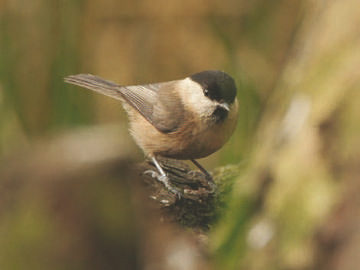
Willow Tit © Steve Round
As a reportedly highly sedentary species (Migration Atlas), there would not be expected to be much difference between the breeding and wintering distributions for Willow Tit. However, this survey shows that they appear to be more widespread in winter. There were 24 tetrads in which Willow Tit was found during the breeding season and not in winter and 30 vice versa. Most of the extra records in winter were within one or two tetrads of one occupied in the breeding season, and could suggest winter dispersal, but others might indicate locations for breeding that had not been found during the breeding season survey. Observers’ attention was drawn to this in an Atlas newsletter in December 2005 but few extra records were forthcoming.
It is thought that adult birds probably remain on their territories in winter (BTO Winter Atlas) and Willow Tits join mixed-species flocks less readily than other tit species. Unlike other tits, they seldom seem to eat nuts such as beech-mast, perhaps because their relatively thin bill is not adapted for cracking them, or it may be just because there are few nut-bearing trees available in their normal habitat. Neither do they take fleshy fruits and they seem to eat invertebrates whenever they can find them, even during winter. Mead (2000) suggested that, as a small sedentary bird, Willow Tit would be susceptible to cold weather but in fact their national population index was stable during the last decade with hard winters – the 1980s – and has crashed since. It does seem likely that lack of winter food, in any weather, is likely to underlie their decline (Siriwardena 2004).
Most of the Willow Tit records were of one or two birds, with three seen together in three tetrads. The winter habitat codes show rather fewer in wet woodland than during the breeding season, just 7 tetrads recording broadleaved carr, with 10 tetrads holding birds in scrub, 13 records from broadleaved woodland, and 7 from mixed woodland. Despite their supposedly sedentary nature, there were suggestions that birds had spread out from breeding sites into a wider range of habitats, with 7 records of birds in farmland hedgerows and 11 in human sites, several of them feeding stations. Another indication of their more widespread winter distribution was that there were eight tetrads in which Willow Tits and Marsh Tits were both found during this Atlas; in all cases both species were recorded in the same winter.
The species was not identified in Cheshire until 1912, and neither Boyd nor Bell made any significant comment on Willow Tits in winter.
There are probably few counties in which Willow Tit is more numerous than Marsh Tit. In view of this, and its national decline, a more detailed survey of this species in Cheshire is surely warranted.
Sponsored by Nantwich Natural History Society

